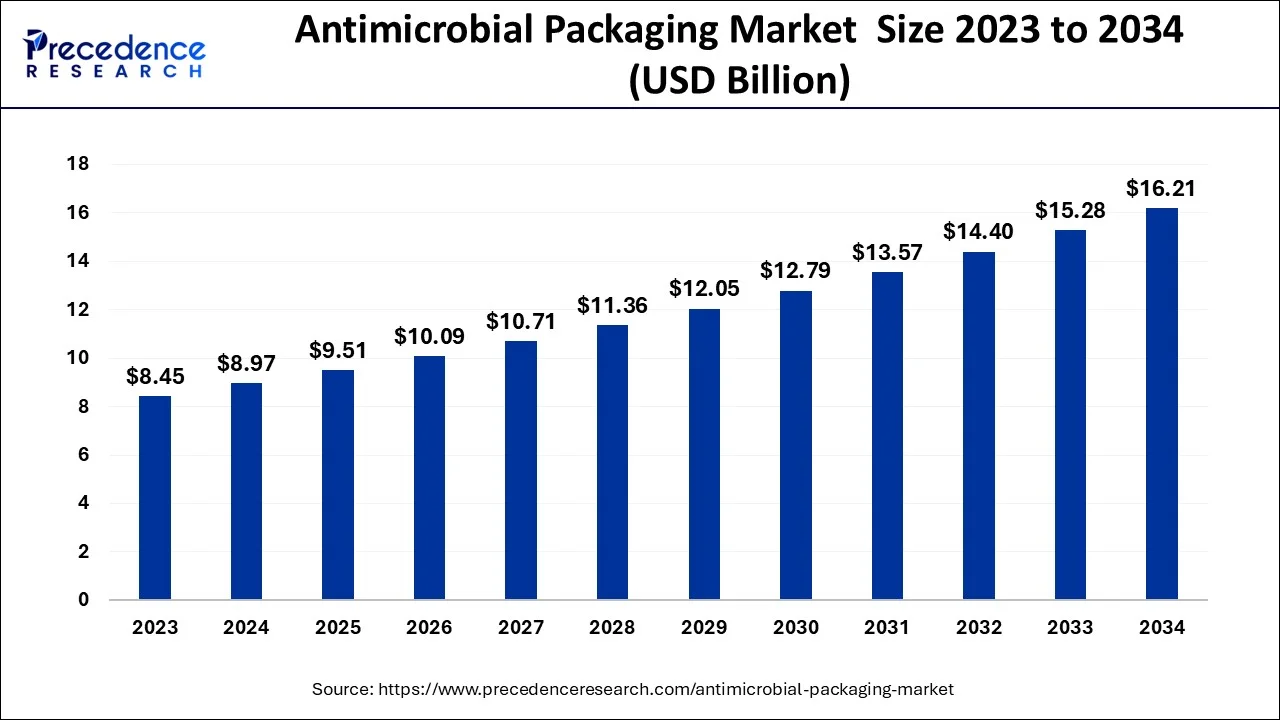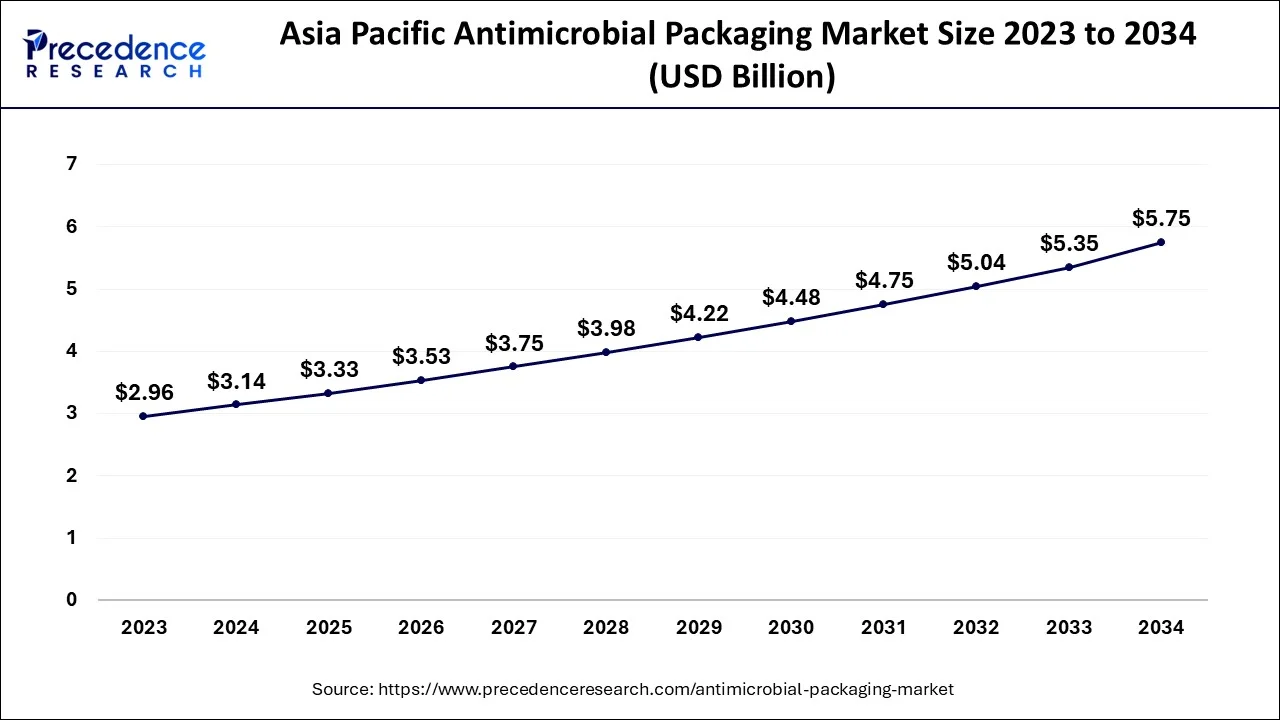January 2025
The global antimicrobial packaging market size accounted for USD 8.97 billion in 2024, grew to USD 9.51 billion in 2025 and is predicted to surpass around USD 16.21 billion by 2034, representing a healthy CAGR of 6.10% between 2024 and 2034.
The global antimicrobial packaging market size is estimated at USD 8.97 billion in 2024 and is anticipated to reach around USD 16.21 billion by 2034, expanding at a CAGR of 6.10% from 2024 to 2034.

The Asia Pacific antimicrobial packaging market size is evaluated at USD 3.14 billion in 2024 and is predicted to be worth around USD 5.75 billion by 2034, rising at a CAGR of 6.22% from 2024 to 2034.

The Asia-Pacific region currently controls a large portion of the anti-microbial packaging market and is anticipated to continue to do so during the projected period. The market for antimicrobial packaging has grown significantly in recent years as a result of the region's fast rising demand for packaged foods and drinks as well as the rising frequency of food poisoning cases and crises reported there. Due to rising employment and a fast-paced lifestyle in the major nations of the Asia Pacific area, packaged foods are gaining popularity in the region. Governmental groups have also been contributing to the growth of food awareness.

Antimicrobial packaging prevents the development or decay of bacteria that might compromise the quality and safety of packaged goods. In this procedure, the idea of "Active Packaging" was established, where various active compounds are added to the packaging material to improve its functioning. The rising demand for packaged food is one of the major factors driving the antimicrobial packaging industry.
The demand for packaged food is fueled by an increasing proportion of working women, rural-urban mobility, and rising disposable income in developing nations. Sometimes people choose packaged food over fresh food because of its quality and cleanliness. Additionally, it is made convenient and tasty. Additionally, the use of antimicrobial packaging materials has increased as a result of growing consumer awareness of consumer health and longer product shelf lives. Food that is ready to eat, has had little processing, and has been promptly prepared is becoming more and more necessary. For instance, according to industry predictions, revenue from the ready-to-eat (RTE) food market is anticipated to reach USD 83,850 million in 2020.
Future packaging trends are anticipated to be influenced by the growth of RTE and grab-and-go meals. Additionally, the beverage packaging industry is finding more and more uses for antimicrobial packaging. Alcoholic, nonalcoholic, fruit juices, flavored milk, wines, and beverages made from dairy products are all being given a longer shelf life by the use of antimicrobial agents. In addition, it is anticipated that throughout the forecast period, rising consumer demand for baked and confectionary goods in emerging economies would drive market expansion.
Additionally, there has been an increase in the number of patients with the virus during the COVID-19 pandemic. The patients are more vulnerable to bacterial and fungal secondary infections. According to information regarding the viral illness (COVID-19) obtained from The Lancet, 50% of patients who died from the virus also had secondary infections. Therefore, the market has plenty of room to grow throughout the projection period because of the hopeful healthcare sector.
As customers become more worried about their health and products have longer shelf life, antimicrobial packaging materials are being employed more frequently. Fast food and minimally processed ready-to-eat foods are in greater demand every day. For instance, industry predictions indicate that sales from the ready-to-eat food category would surpass 83 thousand USD million in 2020. Of the next years, it is projected that the market for antimicrobial packaging would expand due to the increase in ready-to-eat and grab-and-go meals.
Rising consumer market demand for baked goods and confectionary items in emerging countries is anticipated to support the market growth of antimicrobial packaging during the forecast period. Antimicrobial packaging also improves food quality by preventing foreign substances like vapor and pressured liquids from entering the container. Food that has been packed should contain enough oxygen. Particularly, oxygen helps to stop decaying and dangerous microorganisms
| Report Coverage | Details |
| Market Size in 2024 | USD 8.97 Billion |
| Market Size by 2034 | USD 16.21 Billion |
| Growth Rate from 2024 to 2034 | CAGR of 6.10% |
| Base Year | 2023 |
| Forecast Period | 2024 to 2034 |
| Segments Covered | Material Type, Agent Type, Pack Type, Technology, Application, and Geography |
Increasing Consumer Awareness of Health-Related Issues
Raising consumer awareness of issues relating to their health
The antimicrobial packaging market has been dominated by plastic usage. Plastics are excellent for packing because they are inexpensive, versatile, easy to manufacture, and moisture resistant. Due to these characteristics, plastic is often used in antimicrobial packaging. Biopolymers, such as bioplastics, are biodegradable substances utilized in this kind of packaging. They may be used as trays and films, which are useful for maintaining fresh products and extending shelf life. On the other hand, because they are eco-friendly, paper and paperboard are also utilized for packaging. Because they are organic, these components don't affect the product within. The use of packing materials made of paper is a result of growing environmental concerns. Others include readily contaminable items like glass and metals.
The organic acid is the largest category in the antimicrobial agents market since it is used as a preservative in food applications. To extend shelf life and maintain microbiological food safety, the organic acid is put into packing materials. On the other hand, certain species of the archaea and some bacteria create proteinaceous poisons known as bacteriocins. They protect food from spoilage and harmful microorganisms by acting as possible natural preservatives. Typically, they are used to package non-fermented goods like processed meats, pre-made vegetable salads, and others. The market for antimicrobial packaging is anticipated to expand as consumer demand for packaged goods rises.
When it came to type, pouches dominated the antimicrobial packaging industry. Numerous sectors, including those in agriculture, food, healthcare, and personal care, use these pouches extensively for a variety of purposes. The food and beverage industries utilize carton packaging extensively; it is often constructed of paper-based packaging materials that keep germs from contaminating the food. In the healthcare sector, bags are often utilized in the packing of medical devices such tubing, connectors, syringes, as well as a variety of molded parts.
Consumption of antimicrobial packaging has increased in this business due to the rise in packaged food demand. This packaging offers benefits such food preservation and has antimicrobial activity due to its close proximity to the food market, which can support market expansion. The healthcare and pharmaceuticals sector, which dominates the antimicrobial packaging market, provides a number of benefits over conventional packaging materials, including simplicity of use, sterility, affordability, cleanliness, and convenience.
The personal care sector is expanding as a result of consumers with high disposable money altering their lifestyles. Due to the negative effects that low-quality products have on the skin and the body, these elements are raising consumer awareness of the importance of buying excellent and high-quality items. These goods may result in skin rashes, infections, and other illnesses if they are contaminated. Antimicrobial packaging materials are becoming more popular as a result of the high demand for higher-quality products from the consumer base. These elements, together with the focus on sustainable packaging by regional and national government agencies, are further boosting the need for antimicrobial packaging marketing on a worldwide scale.
By Material Type
By Agent Type
By Pack Type
By Technology
By Application
By Geography
For inquiries regarding discounts, bulk purchases, or customization requests, please contact us at sales@precedenceresearch.com
No cookie-cutter, only authentic analysis – take the 1st step to become a Precedence Research client
January 2025
January 2025
January 2025
March 2025